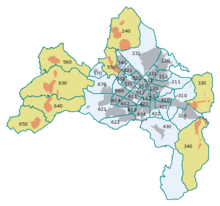User:Tuemmler50000/population development

This article displays the population development Freiburg im Breisgau tabularly and graphically.
Population Development[edit]
In the Late Middle Ages and the early Modern era, between 5,000 and 10,000 people lived in Freiburg. Freiburg was the largest city between Basel and Strasbourg. The population grew very slowly and declined again and again due to the numerous wars, epidemics and famines. Only with the beginning of Industrialisation in the 19th century did the population growth accelerate. In 1800 the city had around 9,000 inhabitants, then by 1900 it was already 62,000. In the year 1934, the population of the city exceeded the limit of 100,000, which made it into a German Großstadt (large city). According to the census of 17th May 1939, the inhabitants were counted at 110,110.
In World War II the city was the target of allied forces air attacks. On the evening of the 27th November 1944, the British Royal Air Force bombarded Freiburg in the course of Operation Tigerfish, whereby around 3,000 people died and large parts of the city centre were destroyed. As the French army occupied Freiburg on the 21st April 1945, 60,000 people still lived in the city. Already in 1957 the population exceeded, once again, the limit of 100,000, through the return of forced evacuees and displaced people from the Former eastern territories of Germany.
By 1963, 150,000 people were already living in the city. The 200,000-mark was surpassed in 1996. The "Amtliche Einwohnerzahl" (official population size), as stated by the statistical state office of Baden-Wuerttemberg in their update on the 31st of December, was 224,191 (principal residences only). With a population growth of 28 percent from 1980 to 2010, Freiburg was the fastest growing large city in Baden-Wuerttemberg. With an average age of 40.3 years Freiburg is also the city with the youngest population of the state.
In the case of Freiburg, however, the official data of the State Statistical Office now differ considerably from the equally official data of the Municipal Residents' Registration Office. Its estimation of 203,240 inhabitants on 1st January 2010 was over 18,000 inhabitants, or almost 10 percent lower than the number updated by the state authority.[1] For each inhabitant registered with the State Statistical Office, the city currently receives 750 Euros per year as an allocation of funds from the state. According to the census on 9 May 2011, the Residents' Registration Office expected a population that would be significantly closer to that of the Residents' Registration Office, possibly even less than 200,000. The determined and published figure of 209,628 inhabitants was higher than expected. The country's financial allocations will be gradually adjusted to the sum calculated from the new numerical basis until 2016 [needs update] after the figure has been taken over by the State Office. The figure of 209,628 inhabitants, published on the 31st May 2013, means that the city will receive 15 million Euros less from the countryside per year. This is 2.5 million more Euros lost in revenue than the city treasurer had taken into account in its planning. [2]
The statistics below show the population of the particular area. These are mostly estimates until 1821, and then population census or official updates of the city government (until 1970) or by the National Statistical Office (from 1971). These specifications refer to the „Zollabrechnungsbevölkerung“ (population paying customs) since 1834, to the „ortsanwesende Bevölkerung“ (residing population) since 1871, to the resident population since 1925 and to the „Bevölkerung am Ort der Hauptwohnung“ (principal residence population) since 1987. The population was not accounted for by a standard measure before 1834.
From 1385 To 1870[edit]
(Respective Territory)
|
|
¹ Census Results
From 1871 to 1944[edit]
(Respective Territory)
|
|
|
¹ Census results
Source: Town Management, Freiburg im Breisgau
From 1945 until 1989[edit]
(Respective Territory)
|
|
|
¹ Census Results
From 1990[edit]
(Respective Territory)
|
|
|
Source: Statistical Office of Baden-Württemberg and de.statista.com
Population Projection[edit]
The Internet platform "Wegweiser Kummune" of the Bertelsmann Stiftung provides data on the development of the population from 2,959 municipalities in Germany. They predict (as of January 2018) a growth in Freiburg's population of 11.9 percent between 2009 and 2030.[3]
The population projection of Bertelsmann-Stiftung is based on the data of the State Statistical Office, not that of the Municipal Registration Office. The municipal population projection of the registration office from the year 2012 assumes a 7.3% increase from the same year. With the inclusion of the municipal population figure from 2009, this yields a projected growth of 8.1% (17,185 people) until 2030.
However, is must be taken into account that the projected numbers for 2015 lie at around 220,000 or 230,000 inhabitants, which is around 10,000 to 20,000 higher than the 2013 cited official number (almost 210,000 inhabitants). This is according to the results of the 2011 census.
|
In "Wegweiser Demographic Change 2020", published in 2006, a population growth in Freiburg between 2003 and 2020 of 7.3 percent (15,384 people) was predicted. This applies to those who live in Freiburg as their main residence.
|
Population structure[edit]
Population groups[edit]
The foreign population in Freiburg constitutes 38,935 inhabitants.
| Nationality |
Inhabitants |
|---|---|
| 3,211 | |
| 2,603 | |
| 1,992 | |
| 1,761 | |
| 1,652 | |
| 1,574 | |
| 1,382 | |
| 1,125 | |
| 1,124 |
Age Distribution[edit]

The statistic below shows the age distribution on the 31st December 2011 (principal residences).
| Age from–to | Inhabitants | Percentage |
|---|---|---|
| 0–5 | 12,051 | 5.7 |
| 6–17 | 21,554 | 10.3 |
| 18–24 | 25,916 | 12.3 |
| 25–29 | 20,465 | 9.7 |
| 30–39 | 29,381 | 14.0 |
| 40–49 | 30,547 | 14.5 |
| 50–59 | 25,855 | 12.3 |
| 60–64 | 9,910 | 4.7 |
| über 65 | 34,598 | 16.5 |
| Gesamt | 217,547 | 100.0 |
source: Registration office of Freiburg im Breisgau
City Districts[edit]

The population numbers are from the 31st December 2006 (living population). [7] The source is the population register of the city of Freiburg. The numbers of this register are much lower than those published by the Statistical State Office.
| Number |
Name |
Area in km² |
Inhabitants number |
Inhabitants per km² |
Foreign nationals number |
Foreign nationals in % |
|---|---|---|---|---|---|---|
| 111 | Altstadt-Mitte | 0.57 | 3,833 | 6,725 | 632 | 16.5 |
| 112 | Altstadt-Ring | 0.62 | 3,554 | 5,732 | 555 | 15.6 |
| 120 | Neuburg | 1.64 | 4,554 | 2,777 | 587 | 12.9 |
| 211 | Herdern-Süd | 2.86 | 5,585 | 1,953 | 494 | 8.8 |
| 212 | Herdern-Nord | 1.43 | 5,505 | 3,850 | 665 | 12.1 |
| 220 | Zähringen | 3.13 | 8,432 | 2,694 | 1,002 | 11.9 |
| 231 | Brühl-Güterbahnhof | 0.9 | 6,137 | 6,819 | 964 | 15.7 |
| 232 | Brühl-Industriegebiet | 10.07 | 795 | 79 | 355 | 44.7 |
| 240 | Hochdorf | 10.11 | 5,111 | 506 | 502 | 9.8 |
| 310 | Waldsee | 4.83 | 5,538 | 1,147 | 416 | 7.5 |
| 320 | Littenweiler | 4.12 | 7,579 | 1,840 | 980 | 12.9 |
| 330 | Ebnet | 6.87 | 2,567 | 374 | 142 | 5.5 |
| 340 | Kappel | 13.82 | 2,667 | 193 | 129 | 4.8 |
| 410 | Oberau | 1.28 | 6,611 | 5,165 | 768 | 11.6 |
| 421 | Oberwiehre | 1.90 | 6,713 | 3,533 | 557 | 8.3 |
| 422 | Mittelwiehre | 1.36 | 4,481 | 3,295 | 388 | 8.7 |
| 423 | Unterwiehre-Nord | 0.78 | 5,013 | 6,427 | 505 | 10.1 |
| 424 | Unterwiehre-Süd | 1.92 | 7,286 | 3,795 | 1,017 | 14 |
| 430 | Günterstal | 15.1 | 1,733 | 115 | 152 | 8.8 |
| 511 | Stühlinger-Beurbarung | 0.51 | 2,599 | 5,096 | 620 | 23.9 |
| 512 | Stühlinger-Eschholz | 0.89 | 6,545 | 7,354 | 1,010 | 15.4 |
| 513 | Alt-Stühlinger | 0.85 | 8,985 | 10,571 | 1,814 | 20.2 |
| 521 | Mooswald-West | 0.97 | 3,936 | 4,058 | 307 | 7.8 |
| 522 | Mooswald-Ost | 0.66 | 3,609 | 5,468 | 765 | 21.2 |
| 531 | Betzenhausen-Bischofslinde | 1.36 | 8,525 | 6,268 | 1,813 | 21.3 |
| 532 | Alt-Betzenhausen | 0.83 | 5,145 | 6,199 | 640 | 12.4 |
| 540 | Landwasser | 1.25 | 7,001 | 5,601 | 1,019 | 14.6 |
| 550 | Lehen | 3.57 | 2,395 | 671 | 183 | 7.6 |
| 560 | Waltershofen | 7.58 | 2,265 | 299 | 117 | 5.2 |
| 570 | Mundenhof | 1.45 | 48 | 33 | 1 | 2.1 |
| 611 | Haslach-Egerten | 1.09 | 6,276 | 5,758 | 1,012 | 16.1 |
| 612 | Haslach-Gartenstadt | 1.04 | 7,727 | 7,430 | 1,484 | 19.2 |
| 613 | Haslach-Schildacker | 0.45 | 743 | 1,651 | 142 | 19.1 |
| 614 | Haslach-Haid | 0.84 | 3,770 | 4,488 | 447 | 11.9 |
| 621 | St. Georgen-Nord | 8.12 | 9,145 | 1,126 | 912 | 10 |
| 622 | St. Georgen-Süd | 2.55 | 2,336 | 916 | 116 | 5 |
| 630 | Opfingen | 14.63 | 4,213 | 288 | 307 | 7.3 |
| 640 | Tiengen | 8.38 | 3,249 | 388 | 342 | 10.5 |
| 650 | Munzingen | 6.77 | 2,755 | 407 | 238 | 8.6 |
| 660 | Weingarten | 1.63 | 10,525 | 6,457 | 2,511 | 23.9 |
| 670 | Rieselfeld | 3.93 | 9,469 | 2,409 | 942 | 9.9 |
| 680 | Vauban | 0.41 | 5,322 | 12,886 | 595 | 11.2 |
| Freiburg | 153.08 | 210,277 | 1,374 | 28,147 | 13.4 |
See also[edit]
Literature[edit]
- Kaiserliches Statistisches Amt (Hrsg.): Statistisches Jahrbuch für das Deutsche Reich. 1880–1918.
- Statistisches Reichsamt (Hrsg.): Statistisches Jahrbuch für das Deutsche Reich. 1919–1941/42.
- Deutscher Städtetag (Hrsg.): Statistisches Jahrbuch Deutscher Gemeinden. 1890 ff.
- Statistisches Bundesamt (Hrsg.): Statistisches Jahrbuch für die Bundesrepublik Deutschland. 1952 ff.
- Bertelsmann Stiftung (Hrsg.): Wegweiser Demographischer Wandel 2020. Analysen und Handlungskonzepte für Städte und Gemeinden. Verlag Bertelsmann Stiftung, Gütersloh 2006, ISBN 3-89204-875-4.
Web links[edit]
- Statistisches Landesamt Baden-Württemberg: Bevölkerung und Erwerbstätigkeit
- Statistisches Landesamt Baden-Württemberg: Struktur- und Regionaldatenbank
- Statistik & Wahlen the city of Freiburg
- FR.ITZ - Online-Statistik der Stadt Freiburg
- Bertelsmann-Stiftung: Wegweiser Demographischer Wandel
References[edit]
- ^ Archived (Date missing) at fritz.freiburg.de (Error: unknown archive URL)
- ^ Joachim Röderer: Freiburg: Volkszählung: Zensus lässt Freiburg um 20.000 Einwohner schrumpfen, Badische Zeitung, 31. Mai 2013, abgerufen am 18. Oktober 2013
- ^ "Freiburg im Breisgau - Demographic Change - 2009 - 2017 - Wegweiser Kommune". Retrieved 2020-01-09.
- ^ Bertelsmann-Stiftung: Absolute Bevölkerungsentwicklung 2009–2030[dead link], As of: 7th March 2013
- ^ Prognose 2012: Endbevölkerung Freiburg Gesamtstadt 2012–2030, mittlere Variante[dead link], fritz.freiburg.de, abgerufen am 25. Mai 2013
- ^ "Statistischer Bericht A I 5 – hj 2 / 17 – Einwohnerinnen und Einwohner der Stadt Freiburg am 31. Dezember 2019" (PDF). Amt für Statistik Freiburg. 2020-10-01. p. 36. Retrieved 2020-12-04.
- ^ Stadt Freiburg: Statistisches Jahrbuch (PDF; 2,9 MB)


